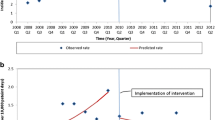Abstract
Clostridium difficile infection (CDI) is a common complication to antibiotic use. Saccharomyces boulardii has shown effect as a prophylactic agent. We aimed to evaluate the efficacy of S. boulardii in preventing CDI in unselected hospitalized patients treated with antibiotics. We conducted a 1 year controlled prospective intervention study aiming to prescribe Sacchaflor (S. boulardii 5 × 109, Pharmaforce ApS) twice daily to hospitalized patients treated with antibiotics. Comparable departments from three other hospitals in our region were included as controls. All occurrences of CDI in patients receiving antibiotics were reported and compared to a baseline period defined as 2 years prior to intervention. Results were analyzed using run chart tests for non-random variation in CDI rates. In addition, odds ratios for CDI were calculated. S. boulardii compliance reached 44% at the intervention hospital, and 1389 patients were treated with Sacchaflor. Monthly CDI rates dropped from a median of 3.6% in the baseline period to 1.5% in the intervention period. S. boulardii treatment was associated with a reduced risk of CDI at the intervention hospital: OR = 0.06 (95% CI 0.02–0.16). At two control hospitals, CDI rates did not change. At one control hospital, the median CDI rate dropped from 3.5 to 2.4%, possibly reflecting the effects of simultaneous multifaceted intervention against CDI at that hospital. The results from this controlled prospective interventional study indicate that S. boulardii is effective for the prevention of CDI in an unselected cohort of mainly elderly patients from departments of internal medicine.




Similar content being viewed by others
References
CDC. Biggest Threats | Antibiotic/Antimicrobial Resistance | CDC. CDC (2016). http://www.cdc.gov/drugresistance/biggest_threats.html
Chiu Y-H, Lin S-L, Tsai J-J, Lin M-Y (2014) Probiotic actions on diseases: implications for therapeutic treatments. Food Funct 5(4):625–634. https://doi.org/10.1039/c3fo60600g
Johnson S, Maziade P-J, McFarland LV et al (2012) Is primary prevention of Clostridium difficile infection possible with specific probiotics? Int J Infect Dis 16(11):e786–e792. https://doi.org/10.1016/j.ijid.2012.06.005
McFarland LV (2010) Systematic review and meta-analysis of saccharomyces boulardii in adult patients. World J Gastroenterol 16(18):2202–2222. https://doi.org/10.3748/wjg.v16.i18.2202
Castagliuolo I, Riegler MF, Valenick L, LaMont JT, Pothoulakis C (1999) Saccharomyces boulardii protease inhibits the effects of Clostridium difficile toxins a and B in human colonic mucosa. Infect Immun 67(1):302–307
Neut C, Mahieux S, Dubreuil LJ (2017) Antibiotic susceptibility of probiotic strains: is it reasonable to combine probiotics with antibiotics? Med Mal Infect 47(7):477–483. https://doi.org/10.1016/j.medmal.2017.07.001
McFarland LV (2015) Probiotics for the Primary and Secondary Prevention of C. difficile Infections: A Meta-analysis and Systematic Review. Antibiot (Basel, Switzerland) 4(2):160–178. https://doi.org/10.3390/antibiotics4020160
Goldenberg JZ, Yap C, Lytvyn L et al (2017) Probiotics for the prevention of Clostridium difficile-associated diarrhea in adults and children. Cochrane Database Syst Rev 12:CD006095. https://doi.org/10.1002/14651858.CD006095.pub4
Anhøj J, Olesen AV (2014) Run charts revisited: a simulation study of run chart rules for detection of non-random variation in health care processes. PLoS One 9(11):e113825. https://doi.org/10.1371/journal.pone.0113825
Anhøj J (2015) Diagnostic value of run chart analysis: using likelihood ratios to compare run chart rules on simulated data series. PLoS One 10(3):e0121349. https://doi.org/10.1371/journal.pone.0121349
R Core Team (2017) R: A Language and Environment for Statistical Computing.
Wickham H. (2017) Tidyverse: Easily Install and Load the “Tidyverse”. R package version 1.2.1.
Anhøj J. (2017) qicharts2: Quality Improvement Charts, R package version 0.2.3.
Ogrinc G, Davies L, Goodman D, Batalden P, Davidoff F, Stevens D (2015) SQUIRE 2.0 (standards for QUality improvement reporting excellence): revised publication guidelines from a detailed consensus process. Can J Diabetes 39(5):434–439. https://doi.org/10.1016/j.jcjd.2015.08.001
Knudsen JD, Andersen SE (2014) Bispebjerg Intervention Group for the BI. A multidisciplinary intervention to reduce infections of ESBL- and AmpC-producing, gram-negative bacteria at a University Hospital. PLoS One 9(1):e86457. https://doi.org/10.1371/journal.pone.0086457
Power M, Wigglesworth N, Donaldson E, Chadwick P, Gillibrand S, Goldmann D (2010) Reducing Clostridium difficile infection in acute care by using an improvement collaborative. BMJ 341:c3359 http://www.ncbi.nlm.nih.gov/pubmed/20659985
Ehrhardt S, Guo N, Hinz R et al (2016) Saccharomyces boulardii to Prevent Antibiotic-Associated Diarrhea: A Randomized, Double-Masked, Placebo-Controlled Trial. Open forum Infect Dis 3(1):ofw011. https://doi.org/10.1093/ofid/ofw011
Szajewska H, Kołodziej M (2015) Systematic review with meta-analysis: Saccharomyces boulardii in the prevention of antibiotic-associated diarrhoea. Aliment Pharmacol Ther 42(7):793–801. https://doi.org/10.1111/apt.13344
Ghantoji SS, Sail K, Lairson DR, Dupont HL, Garey KW (2010) Economic healthcare costs of Clostridium difficile infection: a systematic review. J Hosp Infect 74:309–318. https://doi.org/10.1016/j.jhin.2009.10.016
Funding
The study is financed by internal funding at Copenhagen University Hospital Hvidovre, Denmark.
Author information
Authors and Affiliations
Corresponding author
Ethics declarations
Conflict of interest
All authors declare no conflict of interest.
Ethical approval
The study was a non-randomized intervention study in departments with high frequency of CDI and approved by the hospital director and the hospital administration.
Informed consent
Informed consent by patients was given according to standard treatment procedure and according to Danish law.
Rights and permissions
About this article
Cite this article
Carstensen, J.W., Chehri, M., Schønning, K. et al. Use of prophylactic Saccharomyces boulardii to prevent Clostridium difficile infection in hospitalized patients: a controlled prospective intervention study. Eur J Clin Microbiol Infect Dis 37, 1431–1439 (2018). https://doi.org/10.1007/s10096-018-3267-x
Received:
Accepted:
Published:
Issue Date:
DOI: https://doi.org/10.1007/s10096-018-3267-x




